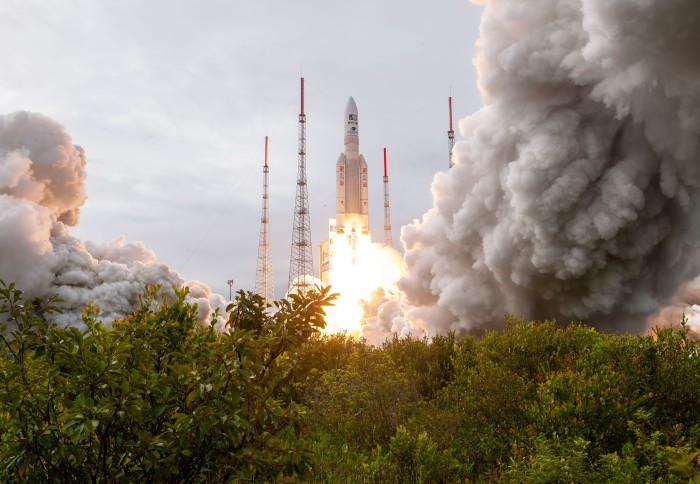Space mission to Jupiter’s icy moons launches with Imperial-built kit on board

The JUpiter ICy moons Explorer (JUICE) has successfully launched, carrying Imperial kit on a mission to assess the habitability of Jupiter’s moons.
JUICE is the European Space Agency’s (ESA) latest flagship mission. The spacecraft launched successfully today at 13:14 UK time, from ESA’s spaceport in Kourou, French Guyana, atop an Arianne 5 rocket.
Working with nine other instruments, the Imperial-led technology - the J-MAG magnetometer instrument - will help to characterise Jupiter’s environment and three of its largest moons: Europa, Callisto and Ganymede.
UK-built space tech
Professor Michele Dougherty, Principal Investigator for the J-MAG instrument and Head of the Department of Physics at Imperial, said: “With our instrument’s measurements, we almost looking inside these worlds. What we’re doing however is extremely difficult, as the signals we’re trying to detect are extremely small. It’s like trying to find lots of needles in a haystack, and those needles are changing shape and colour all the time. But we think the results are going to be spectacular.”

J-MAG can sense magnetic fields five million times smaller than the Earth’s and is built to withstand the extreme temperatures and harsh radiation environment around Jupiter.
J-MAG consists of three sensors – one built at Imperial, one built at the Technical University of Braunschweig, Germany, and one built at the Space Research Institute, Graz in partnership with Technical University Graz, Austria – plus an electronics box and metres of cable assembled at Imperial.
The sensors will be placed along a 10.6-meter boom – twice as long as any ESA has ever built – to keep them away from any magnetic fields created by instruments on the main body of the spacecraft.
The mission
The mission will help scientists determine if any of the moons have the conditions for life, which are: liquid water, a heat source, organic material, and for those three ingredients to be stable enough for long enough. This will inform future missions that may land on these moons, and also help find where else we might look for life beyond our Solar System.
Following a successful launch, JUICE will now use the Earth and Venus for a few gravity assists to swing it out towards Jupiter, arriving in the planet’s system in 2031.

After flying by the moons Europa and Callisto multiple times, JUICE will then go into orbit around Ganymede in 2034 – the first time any spacecraft will orbit a moon other than our own. Ganymede is a prime target because it is the only moon known to create its own magnetic field, and is suspected to have a huge sub-surface ocean beneath a thick icy crust. Europa is also known to have an ocean, and Callisto is expected to.
These oceans are thought to be salty, such that the movement of currents within them leads to small magnetic fields. These fields however are embedded in larger fields from the interior of Ganymede, from Jupiter, and from the Sun itself. All these need to be untangled to sense the extremely small fields from the oceans – predicted to be two million times smaller than Earth’s magnetic field.
On our way
Dr Caroline Harper, Head of Space Science at the UK Space Agency, said: “The launch of JUICE marks years of hard work and collaboration by scientists, engineers and space agencies all over the world, but the journey is far from over. We look forward to following the spacecraft as it makes its eight-year trip to Jupiter and then as it studies the planet and its moons, using specialised UK-developed science instruments.
“We have a large community of research experts in the UK who are eagerly awaiting the data that JUICE will provide. With this information we hope to discover more about the nature of gas giants in space, and their icy moons, bringing us another step closer to understanding the evolution of the Universe.”
Professor Dougherty said: “Space missions are long and slow, so launch only marks the halfway point of this one – because we first started thinking about it 15 years ago, and we'll be getting the last data in 15 years’ time. But this is a huge milestone for us – we’re on our way to Jupiter.”
Secretary of State for Science, Innovation and Technology, Michelle Donelan, said: “The UK Space Agency has invested around £9 million in the JUICE mission to explore Jupiter and its moons. UK tech on the spacecraft illustrates how our world class universities and research institutions are unlocking deep space exploration.
“I want the UK’s space sector to continue thriving and encourage STEM learning for the next generation. It’s important that we push the boundaries of science, innovation and technology across the country to support the jobs of the future.”
The Imperial science team, led by Professor Michele Dougherty, includes Dr Adam Masters and Dr Shivangi Sharan. The instrument build was led by Imperial’s Patrick Brown, with Richard Baughen and Alex Strickland.
During the mission, the team are also partnering with the University of Leicester, who are responsible for radiation analysis, and Kyoto University, Japan, who will support the in-flight calibration of J-MAG.
Follow the team as they watch the launch and successfully deploy J-MAG:
Article supporters
Article text (excluding photos or graphics) © Imperial College London.
Photos and graphics subject to third party copyright used with permission or © Imperial College London.
Reporter
Hayley Dunning
Communications Division